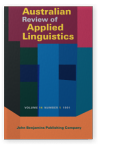Vol. 14:1 (1991) ► pp.17–34
Miscommunication in the medical encounter
A function of language or social roles?
The paper draws upon a study of interaction between staff and non-native speakers of English in the Outpatients Department carried out at the request of a large public hospital. It discusses the nature of communication in the medical setting and the effects of institutionalized models of interaction on patients of both non-English speaking and English-speaking background. An attempt is made to characterize typical language exchanges at various points in patients’ passage through the system and to offer explanations for communication problems arising from selected interactions between patients and hospital staff. Outcomes of these interactions as evidenced by patients’ ability to demonstrate understanding of their medication regimes are also considered.
While according cross-cultural factors an important role in communication with non-English speakers, and accepting that NESB patients on account of their limited English may be disadvantaged in the medical encounter, it was concluded that communication difficulties can arise intraculturally as well as cross-culturally and that the differentiated roles of staff and patients constitute the overriding constraint on effective communication. Implications are drawn for the ways in which social interaction between unequal parties is mediated through language.
